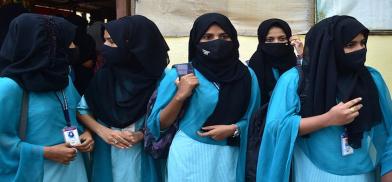To wear or not to wear the hijab: Global polarisation over a piece of clothing
Just like the crisis in Islam itself, the hijab will continue to spark controversies with its fair share of supporters and antagonists. Wearing the hijab is seen by many women as an exercise of their agency - the freedom to wear clothes of their woman’s choice, I have the right to wear whatever I deem fit is good for me; the state, society and community cannot dictate my choice of clothing.

Culture is a complex institution; it is regarded as the fusion of age-old customs, traditions, language, religion etc. In culture, dress codes or dress forms play a crucial role in shaping customs and traditions. In this context, the hijab, the veil that conservative Muslim women wear to cover their heads, has gained national and international spotlight. The hijab is a symbol of many different expressions that have several shades and aspects.
A symbol of oppression
For the staunch advocates of Samuel P Huntington’s ‘Clash of Civilisations’ thesis and liberals, the hijab is a symbol of oppression and patriarchal society which is designed to not just deliberately marginalise Muslim women but to keep them confined to the domestic sphere. Feminists’ particularly radical feminists from different parts of the world view the hijab as the manifestation of outdated Islamic practice which was symbolic of Islam in its pristine form as it existed in the 8th century.
The death of a young woman in Iran who was manhandled and beaten brutally by Iran’s morality police lead to massive protests across the country. Both women and men hit the streets demanding a liberalisation of the conservative Islamic country’s practices. On social media platforms like Facebook, Instagram, WeChat etc women are seen burning the hijab and cutting their hair short to show their immense discontentment with the conservative practice. At many protest sites, women are seen taking off their hijab to display their solidarity with the victim.
Perhaps the best evidence of the hijab as a symbol of oppression is in Afghanistan. Following the Taliban victory in August 2021 the much hated Ministry of Vice and Virtue was resurrected. It immediately made not just the hijab but also a full covering from face to toe mandatory across the country. This invited global condemnation, the UN’s Office for the High Commissioner for Human Rights condemned this diktat as a repressive measure that caused a setback to women’s rights in Afghanistan.
The Islamic veil has again come under international spotlight with senior CNN anchor Christine Amanpour declining to wear a hijab in order to interview Iranian President Ebraham Raisi leading to the cancellation of the interview. She was praised for her bold stand but this only highlights the global polarisation surrounding this controversial piece of clothing.
A symbol of liberty
The hijab is interestingly seen as a symbol of liberty as well. When the Karnataka government banned the wearing of hijab in educational institutions’ premises following a series of controversies when hijab wearing students were not allowed in the school premises women in the state hit the streets in protests demanding the right to wear hijab.
Some prominent universities across India voiced the right of women to go to educational institutions wearing hijab. This issue sparked a national debate on the right of women to attend educational institutions while wearing the hijab. Currently, the Supreme Court is hearing petitions related to this case.
Wearing the hijab is seen by many women as an exercise of their agency - the freedom to wear clothes of their woman’s choice, I have the right to wear whatever I deem fit is good for me; the state, society and community cannot dictate my choice of clothing. This is seen by many liberal Indian scholars like Pratap Bhanu Mehta, Satish Deshpande, Suhas Palshikar etc as the right of women to hit back at the conservative society in general, and the State in particular, which of late has been dictating what people should eat, what they should wear, and what language should they speak.
Just like the crisis in Islam itself, the hijab will continue to spark controversies with its fair share of supporters and antagonists. What is however clear is that the hijab is a piece of clothing that animates conversations about the nature of Islamic society and its customs in general and its place in India’s syncretic culture that is committed to maintaining secularism as the lodestar of the constitution and the country.
(The author is a research associate for Defence Research and Studies(DRAS). Views are personal. He can be contacted at pranayshome1999@gmail.com)
blogs use WYSIWYG editors or if you have
to manually code with HTML. I'm starting a blog soon but have
no coding know-how so I wanted to get advice from someone
with experience. Any help would be greatly appreciated!









Post a Comment